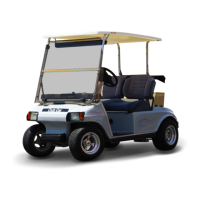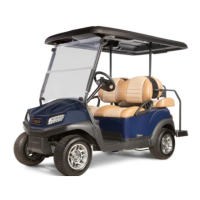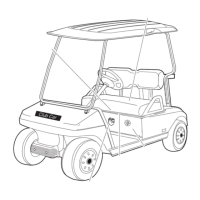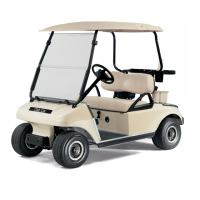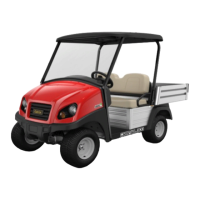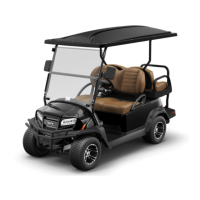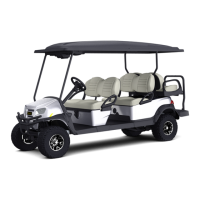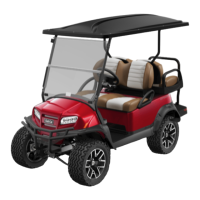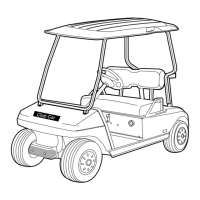Section 3 - General Information Page: 15 Model Identification Information on how to identify your Club Car by its serial number and data plate location.
Safety Committee Recommendations for appointing a safety committee for golf car fleets and their primary concerns.
Pre-Operation Checklist A checklist for inspecting a new Club Car before accepting delivery, covering general parts, labels, and tires.
Performance Inspection Procedure for test driving the vehicle to check brakes, park brake, steering, accelerator, and speed.
Controls Explanation of the vehicle's controls including the key switch, forward/reverse control, and accelerator pedal.
Accelerator Pedal Details on the operation of the accelerator pedal and its function in starting and controlling the vehicle.
Brake Pedal Description of the brake pedal and park brake pedal operation for stopping and parking the vehicle.
Neutral Lock-out Explanation of the neutral lock-out circuit in gasoline vehicles that prevents starting in neutral.
Choke Location and operation of the choke for starting the engine in cool or cold temperatures.
Oil Light Information on the low oil warning light for gasoline vehicles and its function.
Battery Warning Light Explanation of the dash-mounted warning light for PowerDrive System 48 vehicles indicating battery status.
Driving Instructions Instructions for safe operation, starting, driving, stopping, and parking the vehicle.
Towing Guidelines and warnings for towing Club Car vehicles, including tow bar usage and speed limits.
Section 12 - Electrical System Gasoline Vehicles Page: 137 General Information Overview of the 12-volt DC negative ground electrical system and its seven circuits.
The Starter Circuit Explanation of the starter circuit's function, independence from ignition, and power source.
The Generator Circuit Description of the generator circuit, including starter/generator, voltage regulator, and battery.
Engine Ignition Circuit Details on the engine ignition circuit, consisting of igniter, coil, spark plug, and RPM limiter.
Engine Kill Circuit Explanation of the engine kill circuit's function and components for stopping the engine.
Low Oil Warning Circuit Description of the low oil warning circuit, including oil sending unit and dash-mounted light.
Circuit Testing Procedures for testing the entire electrical system without major disassembly.
Starter/Generator Information on the starter/generator, including removal and disassembly procedures.
Section 13 - FE 290 Engine Page: 191 General Information Overview of the FE 290 engine, its cycle, cooling, and major component assemblies.
Special Tools List of required special tools for engine service, with part numbers.
Before Servicing Important information and instructions to read before beginning engine service.
Dirt Instruction to clean the engine thoroughly before servicing.
Tightening Sequence Guidelines for tightening bolts, nuts, and screws in the proper order and method.
Torque Adherence to torque values for assembly and disassembly is crucial for preventing damage.
Force Guidance on using common sense for force in assembly/disassembly and using specific tools.
Lubricant Information on the proper application of oils and greases for engine lubrication.
Lubrication Advice on engine wear during warm-up and applying lubricant to rubbing surfaces.
Press Guidance on installing parts like seals using a press or driver.
Gasket, O-Ring Advice to replace gaskets or O-Rings if in doubt about their condition to avoid leaks.
Engine Rotation Guidance on the correct direction for turning the crankshaft by hand during engine assembly.
Electrical System General advice for working on electrical equipment, emphasizing safety and proper procedures.
Lubrication System Explanation of the pressurized lubrication system components and their functions.
Spark Plug Information on spark plug selection, gap setting, and inspection.
Cylinder Head General information on the cylinder head, including compression testing.
Cylinder Shroud Removal Procedure for removing the cylinder shroud, including disconnecting fuel lines and removing manifold.
Valve Guides Inspection and replacement procedures for valve guides.
Valve Seats Inspection and repair procedures for valve seats.
Valves Visual inspection of valves for wear, discoloration, or stem damage.
Valve Head Thickness Procedure for measuring valve head thickness and checking against service limits.
Valve Stem Bend Instructions for measuring valve stem bend and replacing if it exceeds service limits.
Stem Diameter Procedure for measuring valve stem diameter and checking against service limits.
Valve Springs Inspection of valve springs for damage and measurement of free length.
Push Rods Procedure for inspecting push rods for bend and replacing if necessary.
Piston/Connecting Rod Procedures for removing, inspecting, and installing the piston and connecting rod assembly.
Piston Inspection and repair procedures for the piston, including cleaning and ring groove checks.
Piston Pin Inspection procedures for the piston pin and piston pin hole.
Connecting Rod Inspection procedures for connecting rod bearing surfaces and bolts.
Cylinder Block Inspection of the cylinder block for damage such as cracks or scoring.
Section 14 - Fuel System Page: 241 General Information Overview of the fuel system, including carburetor, fuel filters, lines, and tank vent.
Main System Description of the carburetor's main system components and their function in fuel metering.
Slow Speed System Explanation of the slow speed system's function in supplying fuel during low speed running.
Standard Jetting Standard jet sizes for pilot air screw, pilot jet, main jet, and throttle stop screw.
Float System Explanation of the float system that maintains correct fuel level in the carburetor's float chamber.
Carburetor Check of fuel and ignition systems before suspecting carburetor issues.
Governor Cable Procedure for removing and installing the governor cable, including adjustment.
Air Filter Element General information on the air filter element, including service intervals and replacement.
Fuel Filters General information on fuel filters, including inspection and replacement guidelines.
Fuel Pump General information on the impulse fuel pump and troubleshooting steps.
Fuel Pump Removal Instructions for removing the fuel pump from the engine compartment.
Fuel Tank General information on the fuel tank, including off-season storage preparation.
Section 19 A - Electrical System V-Glide 36 Volt Vehicle Page: 317 General Information Overview of the V-Glide 36 volt vehicle's electrical circuitry and components.
The Control Circuit Components of the control circuit: key switch, limit switches, solenoid, and wires.
The Power Circuit Components of the power circuit: speed controller, solenoid, motor, batteries, and wiring.
The Speed Control Circuit Explanation of the speed control circuit for multi-step and continuously variable potentiometer models.
The Charge Circuit Components of the charge circuit: OBC, charger, plug, receptacle, fuse link, and batteries.
Section 22 - Batteries Page: 453 General Information Overview of golf car batteries vs. automotive batteries and their characteristics.
Battery Care Preventive maintenance steps to keep batteries in good operating condition.
Self-Discharge Information on battery self-discharge rates affected by dirt, acid, and weather.
Water Level Guidelines for maintaining proper water level in batteries after charging.
Mineral Content Allowable mineral content limits for water used in batteries.
Vibration Damage How battery hold-downs affect battery life and potential damage from vibration.
Battery Charging General information on the Club Car DS Electric Vehicle's automatic battery charger.
Hydrometer Test Procedure for measuring battery specific gravity to determine state of charge.
Battery Storage Guidelines for storing batteries during off-season or maintaining stock.


